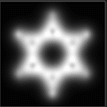This page contains the following:
1. What is STM?
Scanning Tunnelling Microscopy (STM) is a microscopy technique which
allows you to see individual atoms on a surface. It works by scanning
an atomic scale tip across the surface of the material. A tiny
tunnelling current passes between the tip and the surface. This
tunnelling current is highly dependant on the density of states. There
are then two ways of operating the microscope:
2. How do we simulate it?
At the moment our work in this area is in the early stages of
development. We are able to accurately model the charge and wave
function spatial distribution in our systems, and from this construct
various contour maps. Current work is based on a benzene molecule
resting on the surface of graphite, however this will be expanded in
the future. We have two MPhys students, J. Hogan and R. MacKie
developing the modelling techniques. The following are some
preliminary test images produced by C. Ewels:
 A Charge density plot of Benzene on Graphite (40K)
A Charge density plot of Benzene on Graphite (40K)
 A wave function plot of the same system (41K)
A wave function plot of the same system (41K)
NB: The carbon atoms on the charge density plot appear as darker dots than the surrounding regions. This is because we use pseudo-potentials to simulate the core electrons that are not involved in bonding. This means that they do not appear in the total charge density, and so appear darker. Since the hydrogen atoms do not have any core states they do not show the same effect.